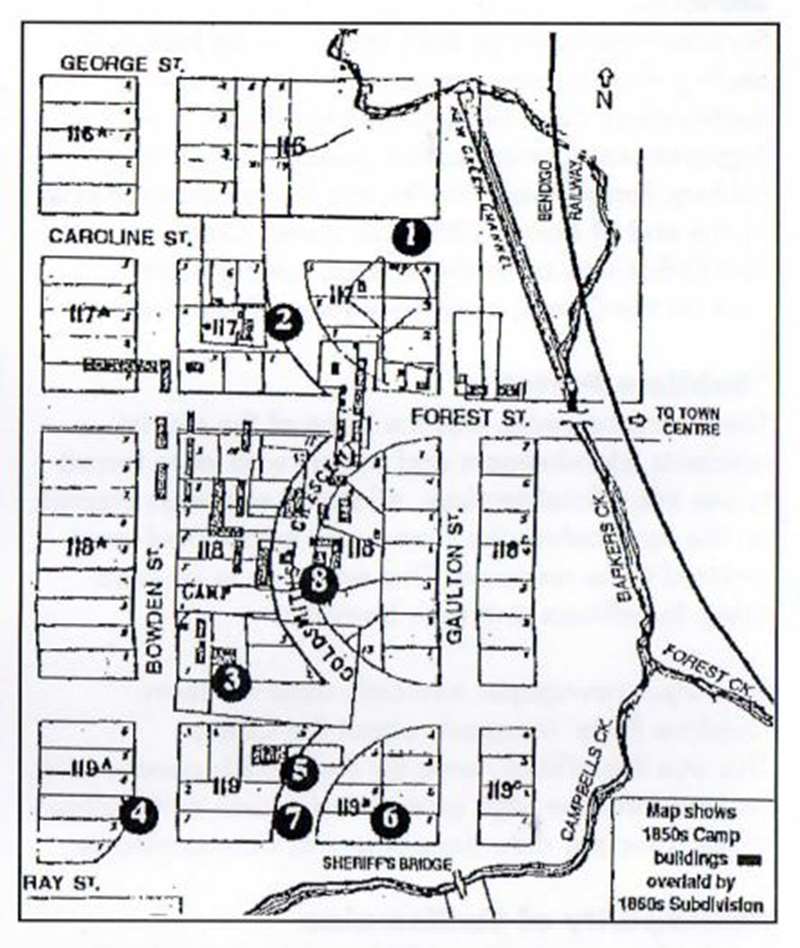Castlemaine Gold Commissioner's Camp Walk


The Former Gold Commissioner's Camp is of local, state and national heritage significance.
Gold was found at Specimen Gully in July 1851. This was the beginning of Mount Alexander Goldfields, Forest Creek Diggings and Castlemaine. Dja Dja Wurrung lands and the pastoral district of central Victoria were radically altered when mass immigration occurred.
Establishment of the Camp
In November 1851, Lieutenant Governor of Victoria, Charles J. LaTrobe, appointed "The Township of Castlemaine, on the Forest Creek, Mount Alexander to be a place for holding of Courts of Petty Sessions." Early in 1852, the Government established a camp at the junction of Forest and Barkers Creeks, where Gold Commissioner William Wright presided.
Name of Castlemaine
In the early 1850s, this locality was variously called; Forest Creek, Barkers Creek, Campbells Creek and Castlemaine.
Buildings
A tent city developed, but was quickly replaced with timber and brick buildings, These were erected to accommodate Government Departments including Gold Commissioners, Police (foot, mounted and escort), Military (40th and 99th Regiments), Gaol, Sheriff, Crown Lands, Postal and Roads Board. Court sittings were held for Petty Sessions, County and Supreme Courts and later the Mining Court.
Officials
The Camp officials were responsible for the Victorian Goldfields administration. Originally all surrounding goldfield's reports were sent to Castlemaine then forwarded to Melbourne by Assistant Commissioner Bull. His district also included Sandhurst (Bendigo) Blackwood, Daisy Hill, Moliagul and Korong, while Sheriff Colles' bailiwick extended up to the Murray River.
Services
Services conducted by the Camp officials included issuing of all licences (gold, storekeepers and auctioneers), controlling the Gold Offices, Civil Registrations, Commissariat, Judicial, Medical, Military, Penal, Public Works and Survey Departments. By the end of March 1852, the Forest Creek Post Office was centrally located, having been built on the Camp, near the Barkers Creek ford.
"Sublime Porte"
The Camp however, was the bane of the district residents, storekeepers and miners who were forced to use the official services. All stores and tents erected on the land before the Camp was established were ordered to be removed. This area was to be used solely for officers and their barracks.
The Argus newspaper ironically used the term 'Sublime Porte' in reports about the Camp. This was the official name for the Turkish government, derived from the high gate giving access to the offices of the principal state department in Constantinople.
Municipality of Castlemaine
Land sales were held in 1853 and the municipality of Castlemaine was formed in 1855. The new town developed on the east side of Barkers Creek. The creek separated the general public, the "Townites", from the officials, the "Campites".
End of Commissioners and the Camp
After Eureka and the 1855 Act for the Better Management of the Goldfields, the Gold Commissioners lost their positions. Captain J.E.N. Bull was appointed Warden for the district.
Land and Buildings Sales
The fate of the Gold Commissioner's Camp was in the hands of the Government. Councillor Gingell was very vocal on matters pertaining to the camp. He was strongly in favour of dismantling the Camp and reserving the area as a Botanical Gardens. In the 1860s, after years of controversy, the land and buildings (with the exception of numbers 2, 3, 5, 6 and 8 as shown on the map) were sold and Camp Reserve created for the use of the Volunteers as a parade and drill ground.
Existing Evidence of the Gold Commissioner's Camp
Little remains of the camp, however, there are five privately owned houses and one public building which have been identified as dating back to the period the camp was the administrative centre of goldfields.

1. Camp Reserve: Temporarily gazetted for the Volunteers as a parade ground it was later gazetted for public purposes in 1895.
2. Burke's Cottage: 31 Gingell Street. Built 1854 as a military hospital. It was never used as such, but occupied by Police Sergeants, Robert O'Hara Burke and Francis A.S. Reid.
3. J.E.N. Bull's Cottage: 5 Yandell Street. Assistant Gold Commissioner Bull and his family were early residents of the Camp.
4. James Ah Coy's Cottage: 5 Bowden Street. A Chinese Government Interpreter, he was dismissed after a dubious trial, on conviction of fraud. His family lived there until the 1950s.
5. Military House: 4 Camp Crescent. Built 1854 for Military and occupied by Captain Blythe. It was used by Police Magistrate, Captain Harrison and then Sergeant Acton.
6. Sheriff's Cottage: 1 Yandell Street. Built 1854 for Sheriff Kingdom and later occupied by Sheriff Richard Colles and his family.
7. Camp Crescent: Named after 'The Camp'.
8. Former Court House: Built in 1852 as a Police Office, it was converted to house the first sitting of the Supreme Court on the Victorian Goldfields in December 1852.
This brochure is the result of primary research conducted by the Castlemaine Historical Society Inc (CHSI) members. It celebrates the Discovery of Gold and the establishment of the Castlemaine Gold Commissioner's Camp in the 1850s
Location
Cnr Caroline Street and Gingell Street, Castlemaine 3450 View Map








